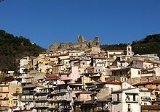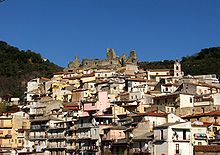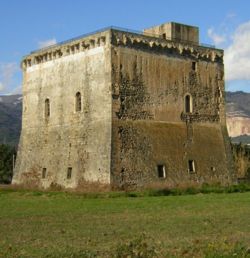
Lamezia Terme
Encyclopedia
Lamezia Terme, commonly named Lamezia, is an Italian city of 71,287 inhabitants in the province of Catanzaro
in the Calabria
region.
While the economic development arrived, although with variabilities, the area of Lamezia saw the increasing power of the local branch of the mafia, the 'Ndrangheta. The municipal administration collapsed twice in 10 years due to mafia infiltrations. Most of the centre-left coalition members elected in 2005 received several death threats.
 Nicastro's origins trace back to the 9th century, when Calabria was part of the Byzantine Empire
Nicastro's origins trace back to the 9th century, when Calabria was part of the Byzantine Empire
, when a fortress called Neo Castrum ("New Castle") was created. A great Benedictine abbey, St. Eufemia, was founded here in 1062 by the Norman count Robert Guiscard
. It was for a long time a fief of the Caracciolo
family and, later, to the D'Aquino. The city was nearly destroyed after an earthquake in 1638 (more than 100 inhabitants died), and the abbey was turned into ruin. The castle, built by the Normans and enlarged by Emperor Frederick II
and the Angevine kings, crumbled down. Floods and a further earthquake followed in the 18th century.
Nicastro experienced the highest rate of emigration during the late 19th and the early 20th century (some 8,000 citizens), as well as after World War II.
The thermal baths of Sambase were great and famous place of comfort and rest for wayfarers, soldiers, messengers, in the ancient times they was called Aque Ange.
The Romans knew Sambiase with the name of Turres, there in fact to check the territory they were situated two towers.
But Sambiase was already existing during the Greek period first with the name of Melea (here they are placed in fact its ancient boundaries) and then Terina (of which numerous coins have been found again in the fraction Acquafredda and also the tesoretto of Sant'Eufemia preserved in the British Museum).
With the fall of the empire,Turres was abandoned and devastated by the Ostrogothic ones
Sambiase resources in the 7th century thanks the Basilianis,that escape from Sicily,they installed him in the Calabrian territory.
The Basilianis monks made to rise numerous Byzantine monasteries, among which that of St. Blase, from which the city's name derived.
The basilianis taught to read and to write to the farmers and they were made important friends among the great Byzantine cities of Italy, Greece and Turkey as Taranto, Naples and Gaeta, thanks to their action the new city, St. Blase, succeeded in exporting its own products, olives, grape, corn, wheat, laughed, to the whole empire.
They formed numerous monasteries and churches of orthodox order as those of the Sts.Forty Martyrs, Saint Sophia, St. Costantin etc. important centers of culture comparable to the great European courts .
In 10th it had numerous churches, of which today only five remain.
Robert Guiscard with his brother Roger during the difficult attempt to conquer Calabria, stopped to the thermal baths together with their team of soldiers.
From that period Sambiase became important and famous Norman University among the preferred places of the Norman sovereigns as the Guiscard, Roger,Federick II and Manfredi, they also strengthened the power of some abbeys of Sambiase as St. Costantine.
With the Aragonese kingdom Sambiase strengthened its own influence on the central government of Naples, many citizens of the ancient university in fact they invested important court positions as mathematicians, astronomers and chamberlains.
Sambiase was a most important for a Spanish and Italian economy.
Main point was the strictness and the share of Sambiase to the Italian wars of independence .
Giovanni Nicotera
was a important personality of Sambiase as Freancesco Fiorentino,Franco Costabile etc.

The central railway station
, on the main line leading from Reggio to Naples, is a major terminal for goods traffic. Secondary branches connect to Catanzaro and Crotone
.
Lamezia is the site of the Lamezia Terme International Airport
, built in 1976. The airport has both national and international connections.
Province of Catanzaro
The Province of Catanzaro is a province of the Calabria region, in Italy. The city of Catanzaro is capital both of the province and of the region.- Demographics :The following is a list of the province of Catanzaro comunes with population over 5,000:...
in the Calabria
Calabria
Calabria , in antiquity known as Bruttium, is a region in southern Italy, south of Naples, located at the "toe" of the Italian Peninsula. The capital city of Calabria is Catanzaro....
region.
Geography
Lamezia is located on the eastern border of the coastal plain commonly called Piana di Sant'Eufemia, which was created by drying a wide marshy area.History
The municipality of Lamezia Terme was formally created on January 4, 1968. Its territory includes those of the former municipalities of Nicastro, Sambiase, Sant'Eufemia Lamezia. The controversial fusion was intended to create a stronger entity capable of a more powerful economical development in what was considered an area of great economical expansion in the late 1960s.While the economic development arrived, although with variabilities, the area of Lamezia saw the increasing power of the local branch of the mafia, the 'Ndrangheta. The municipal administration collapsed twice in 10 years due to mafia infiltrations. Most of the centre-left coalition members elected in 2005 received several death threats.
Nicastro
- Main article NicastroNicastroNicastro was a small town in the province of Catanzaro, in the Calabria region of southern Italy.Since 1968 it constitutes, together with Sambiase and Sant'Eufemia Lamezia, the city of Lamezia Terme.- Geography :...

Byzantine Empire
The Byzantine Empire was the Eastern Roman Empire during the periods of Late Antiquity and the Middle Ages, centred on the capital of Constantinople. Known simply as the Roman Empire or Romania to its inhabitants and neighbours, the Empire was the direct continuation of the Ancient Roman State...
, when a fortress called Neo Castrum ("New Castle") was created. A great Benedictine abbey, St. Eufemia, was founded here in 1062 by the Norman count Robert Guiscard
Robert Guiscard
Robert d'Hauteville, known as Guiscard, Duke of Apulia and Calabria, from Latin Viscardus and Old French Viscart, often rendered the Resourceful, the Cunning, the Wily, the Fox, or the Weasel was a Norman adventurer conspicuous in the conquest of southern Italy and Sicily...
. It was for a long time a fief of the Caracciolo
Caracciolo
Caracciolo is the surname of a famous noble family of southern Italy.Its members include:*Battistello Caracciolo, Italian painter*Carmine Nicolao Caracciolo, Spanish viceroy of Peru*Francesco Caracciolo, Neapolitan admiral and revolutionist...
family and, later, to the D'Aquino. The city was nearly destroyed after an earthquake in 1638 (more than 100 inhabitants died), and the abbey was turned into ruin. The castle, built by the Normans and enlarged by Emperor Frederick II
Frederick II, Holy Roman Emperor
Frederick II , was one of the most powerful Holy Roman Emperors of the Middle Ages and head of the House of Hohenstaufen. His political and cultural ambitions, based in Sicily and stretching through Italy to Germany, and even to Jerusalem, were enormous...
and the Angevine kings, crumbled down. Floods and a further earthquake followed in the 18th century.
Nicastro experienced the highest rate of emigration during the late 19th and the early 20th century (some 8,000 citizens), as well as after World War II.
Sambiase
The baths of Sambiase was in a famous Roman itinerary Tabula Peuntigeriana so it was a important destination.The thermal baths of Sambase were great and famous place of comfort and rest for wayfarers, soldiers, messengers, in the ancient times they was called Aque Ange.
The Romans knew Sambiase with the name of Turres, there in fact to check the territory they were situated two towers.
But Sambiase was already existing during the Greek period first with the name of Melea (here they are placed in fact its ancient boundaries) and then Terina (of which numerous coins have been found again in the fraction Acquafredda and also the tesoretto of Sant'Eufemia preserved in the British Museum).
With the fall of the empire,Turres was abandoned and devastated by the Ostrogothic ones
Sambiase resources in the 7th century thanks the Basilianis,that escape from Sicily,they installed him in the Calabrian territory.
The Basilianis monks made to rise numerous Byzantine monasteries, among which that of St. Blase, from which the city's name derived.
The basilianis taught to read and to write to the farmers and they were made important friends among the great Byzantine cities of Italy, Greece and Turkey as Taranto, Naples and Gaeta, thanks to their action the new city, St. Blase, succeeded in exporting its own products, olives, grape, corn, wheat, laughed, to the whole empire.
They formed numerous monasteries and churches of orthodox order as those of the Sts.Forty Martyrs, Saint Sophia, St. Costantin etc. important centers of culture comparable to the great European courts .
In 10th it had numerous churches, of which today only five remain.
Robert Guiscard with his brother Roger during the difficult attempt to conquer Calabria, stopped to the thermal baths together with their team of soldiers.
From that period Sambiase became important and famous Norman University among the preferred places of the Norman sovereigns as the Guiscard, Roger,Federick II and Manfredi, they also strengthened the power of some abbeys of Sambiase as St. Costantine.
With the Aragonese kingdom Sambiase strengthened its own influence on the central government of Naples, many citizens of the ancient university in fact they invested important court positions as mathematicians, astronomers and chamberlains.
Sambiase was a most important for a Spanish and Italian economy.
Main point was the strictness and the share of Sambiase to the Italian wars of independence .
Giovanni Nicotera
Giovanni Nicotera
Giovanni Nicotera was an Italian patriot and politician. His surname is pronounced , with the stress on the second syllable.-Biography:Nicotera was born at Sambiase, in Calabria....
was a important personality of Sambiase as Freancesco Fiorentino,Franco Costabile etc.
Sant'Eufemia Lamezia
The current Sant'Eufemia Lamezia does not correspond to the ancient city location. The most ancient settlement was the Greek Terina, whose ruins are nowadays being excavated. Sant'Eufemia Lamezia (nowadays Sant'Eufemia Vetere) was created, upon a hill not long after the 1638 earthquake. The current quarter was built in the Fascist era after the drying of a marshy area.
Main sights
- The Castle is today an ensemble of ruins occupying the summit of a hill 320 m high. It was built, according to some scholars http://www.lameziastorica.it/castello1.htm, by the BruttiiBruttiiThe Bruttii , were an ancient Italic people who inhabited the southern extremity of Italy, from the frontiers of Lucania to the Sicilian Straits and the promontory of Leucopetra, roughly corresponding to modern Calabria.-History:...
or by Greeks colonists. The current structure dates probably from the Norman domination, although some structure existed at the time of the Ostrogoth king TeiaTeiaTeia , also known as Teja, Theia, Thila, Thela, Teias, was the last Ostrogothic king in Italy.Apparently a military officer serving under Totila, Teia was chosen as successor and raised over a shield after Totila was slain in the Battle of Taginae in July 552...
. In 1122 Pope Callixtus IIPope Callixtus IIPope Calixtus II , born Guy de Vienne, the fourth son of William I, Count of Burgundy , was elected Pope on February 1, 1119, after the death of Pope Gelasius II . His pontificate was shaped by the Investiture Controversy, which he was able to settle through the Concordat of Worms...
resided here for fifteen days. Later, the castle was enlarged by Constance of Hauteville and his son Frederick II, as well as by the Angevines. The castle was heavily damaged by the earthquakes of 1609, 1638 and 17831783 Calabrian earthquakesThe 1783 Calabrian earthquakes were a sequence of five strong earthquakes that hit the region of Calabria in southern Italy , the first two of which produced significant tsunamis. The epicenters form a clear alignment extending nearly 100 km from the Straits of Messina to about 18 km SSW...
, and subsequently abandoned. - Eco-museum of Lamezia Terme in Sambiase.
- The Bastion of the Knights of MaltaKnights HospitallerThe Sovereign Military Hospitaller Order of Saint John of Jerusalem of Rhodes and of Malta , also known as the Sovereign Military Order of Malta , Order of Malta or Knights of Malta, is a Roman Catholic lay religious order, traditionally of military, chivalrous, noble nature. It is the world's...
is a massive, well-preserved watchtower built in 1550 by the Spanish viceroy of Naples Pedro de Toledo. It was assigned to the Knights, who had a fief in the neighbourhood. Ruins of several other watchtowers are in the area. - Near Sant'Eufemia, the ruins of the Cistercian abbey of Santa Maria di Corazzo can be seen. It was founded around 1060. Joachim of FioreJoachim of FioreJoachim of Fiore, also known as Joachim of Flora and in Italian Gioacchino da Fiore , was the founder of the monastic order of San Giovanni in Fiore . He was a mystic, a theologian and an esoterist...
was an abbot here, and Bernardino TelesioBernardino TelesioBernardino Telesio was an Italian philosopher and natural scientist.While his natural theories were later disproven, his emphasis on observation made him the "first of the moderns" who eventually developed thescientific method.-Biography:...
wrote many of his philosophical works here in 1554. - The abbey of the 40 Martyrs (Lamezia Terme - Sambiase), created in the 9th-10th century, is still active.
- The Diocesan Museum houses an Arab-Norman ivory case (12th century), paintings of 17th-18th centuries and other works.
- The numerous churches of Sambiase di Lamezia Terme are wonderfoul,the most important is Saint Pancrazio's church,here there are some Mattia Preti's pictures,fantastic statues and frescoes. It was a symbol of the new Sambiase in eitheenth century .
Transportation
The central location of Lamezia Terme in Calabria has made it the main transportation hub of the region. The city is situated adjacent to the infamous A3 Salerno-Reggio Calabria Motorway, and the SS.288 State Route runs to Catanzaro from Lamezia.The central railway station
Lamezia Terme Centrale railway station
Lamezia Terme Centrale railway station is the main station serving the city and comune of Lamezia Terme, in the Calabria region, southern Italy...
, on the main line leading from Reggio to Naples, is a major terminal for goods traffic. Secondary branches connect to Catanzaro and Crotone
Crotone
Crotone is a city and comune in Calabria, southern Italy, on the Ionian Sea. Founded circa 710 BC as the Achaean colony of Croton , it was known as Cotrone from the Middle Ages until 1928, when its name was changed to the current one. In 1994 it became the capital of the newly established...
.
Lamezia is the site of the Lamezia Terme International Airport
Lamezia Terme International Airport
Lamezia Terme Airport is an airport near Lamezia Terme, Italy. Its IATA airport code SUF is derived from Sant'Eufemia, the part of Lamezia Terme which the airport is closest to.It is the most important Calabrian airport and is under continuous development...
, built in 1976. The airport has both national and international connections.
See also
- List of cities in Italy by population
- Vigor LameziaVigor LameziaVigor Lamezia is an Italian association football club, based in Lamezia Terme, Calabria. The club was founded in 1919 and refounded in 1975. Vigor Lamezia currently plays in Lega Pro Seconda Divisione. The team's colors are green and white....
- Calabrian wine

